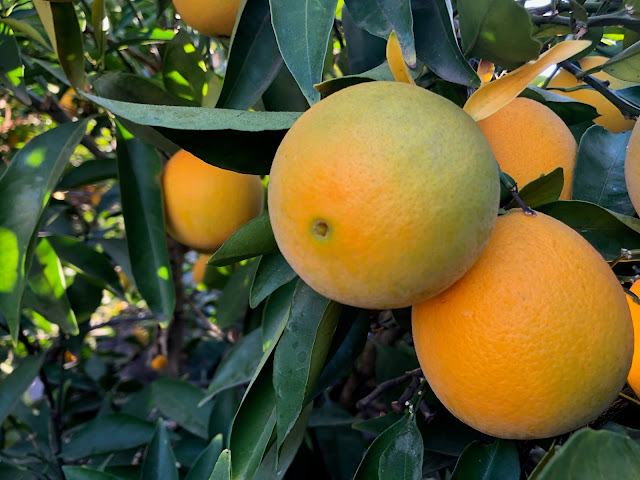
Protect those trees and your imminent harvest

|
|
These Washington navel oranges are coloring up quickly, but likely won't be ripe until late December or even later. (Photo: Kathy Morrison)
|
For gardeners, the ripening of the mandarins heralds the beginning of a new season: Citrus Worrying.
Temperatures have dropped, and frost warnings are already part of the conversation.
Ironically, popular mandarins are among the most cold-hardy of citrus varieties, Owari Satsumas especially. The fruit can endure cold down to 28 degrees F. before it is damaged.
Sweet oranges of all varieties also are likely to withstand cold, to 28 degrees, as are kumquats. But limes, lemons, citron and Oroblanco grapefruit are among the least cold-hardy, to just 32 degrees. (For specific varieties' cold tolerance, see this terrific citrus variety info chart from the citrus wholesalers at Four Winds Growers in Winters.)
So you have your frost blankets ready, right? Here are other things to keep in mind about citrus this month and into winter:
-- Citrus ripens only on the tree, so leave it there even if it has changed color. My Washington navel oranges are turning color a tad early this year. But they generally don't ripen until after Christmas, so I will keep on eye on them through December. How to tell when an orange is ripe: The rind starts to soften just a bit. If you're unsure, pick and taste one!
-- Store ripe citrus on the tree, as long as there are no freezes in the forecast. The exception to this is mandarins, which should be picked as soon as they are ripe.
-- If branches loaded with ripe citrus fruit are bending under the weight, prop the branches up so they don't snap off. A few 2-by-4s are useful for this; for my dwarf navel I've even used tall tomato cages in a pinch. (Thinning fruit in summer will prevent this situation, of course, but there's always a cluster of fruit you didn't catch early.)
-- If frost is in the forecast, water the root zone of your citrus tree before temps drop. Wet soil conducts heat better than dry soil and will help those frost blankets protect the tree. (Do make sure the frost blanket or other covering extends to the ground or you're defeating the purpose of the covering.) You might want to rake any mulch away from the dripline so the soil can absorb daytime heat and be a better heat reservoir.
-- Don't water the branches and leaves of the tree, by the way -- the frozen water will just add to the weight of the branches.
-- If you want to use old-fashioned Christmas lights to help protect your tree, put them on early and leave them there. It's no fun trying to string them on the tree on a cold late afternoon just as the sun is going down.
-- Citrus fruit, of course, is less hardy than the plant itself. If you lose fruit to cold, that doesn't mean the tree is dead. It may be months before you can assess how damaged the tree is, so don't prune off anything: Any apparently dead leaves and branches will protect the rest of the tree during the cold season.
-- Young trees are more susceptible to freezing, so be sure to protect them even if the forecasted temps wouldn't threaten a mature tree.
-- Along a fence or the side of the house are the best places to park citrus in containers. The ambient heat from the house will help keep it warm; the fence is a good place to attach the frost covering. I group my potted citrus together, too.
For more on citrus care, check out the Sacramento County master gardeners' website at The Home Orchard , which includes several links to citrus topics. I also recommend the "Growing Citrus in Sacramento" Garden Note #127 .
Comments
0 comments have been posted.Sacramento Digs Gardening to your inbox.
Sites We Like
Garden Checklist for week of April 21
This week there’s plenty to keep gardeners busy. With no rain in the immediate forecast, remember to irrigate any new transplants.
* Weed, weed, weed! Get them before they flower and go to seed.
* April is the last chance to plant citrus trees such as dwarf orange, lemon and kumquat. These trees also look good in landscaping and provide fresh fruit in winter.
* Smell orange blossoms? Feed citrus trees with a low dose of balanced fertilizer (such as 10-10-10) during bloom to help set fruit. Keep an eye out for ants.
* Apply slow-release fertilizer to the lawn.
* Thoroughly clean debris from the bottom of outdoor ponds or fountains.
* Spring brings a flush of rapid growth, and that means your garden is really hungry. Feed shrubs and trees with a slow-release fertilizer. Or mulch with a 1-inch layer of compost.
* Azaleas and camellias looking a little yellow? If leaves are turning yellow between the veins, give them a boost with chelated iron.
* Trim dead flowers but not leaves from spring-flowering bulbs such as daffodils and tulips. Those leaves gather energy to create next year's flowers. Also, give the bulbs a fertilizer boost after bloom.
* Pinch chrysanthemums back to 12 inches for fall flowers. Cut old stems to the ground.
* Mulch around plants to conserve moisture and control weeds.
* From seed, plant beans, beets, cantaloupes, carrots, corn, cucumbers, melons, radishes and squash.
* Plant onion sets.
* In the flower garden, plant seeds for asters, cosmos, celosia, marigolds, salvia, sunflowers and zinnias.
* Transplant petunias, zinnias, geraniums and other summer bloomers.
* Plant perennials and dahlia tubers for summer bloom.
* Mid to late April is about the last chance to plant summer bulbs, such as gladiolus and tuberous begonias.
* Transplant lettuce seedlings. Choose varieties that mature quickly such as loose leaf.